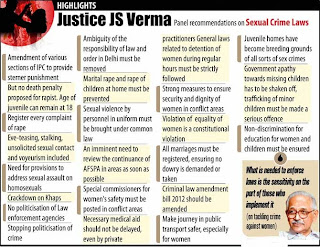The Justice J S Verma committee has raised the bar of punishment for a wide range of existing and proposed sexual offences even as it rejected the demand for introducing death for rape.
The report has proposed codification of a stringent alternative to the life sentence, evolved through judicial activism in the last five years. Unlike the existing life sentence in which the convict is likely to be released after 14 years, at the discretion of the government, the Verma committee’s alternative would statutorily bar him from being released for 20 years or for “the rest of that person’s natural life”.
This new variety of ‘long life’ or ‘whole life’ sentence has been recommended for aggravated forms of sexual assault: rape causing death or persistent vegetative state, gangrape, repeat offenders of rape, rape of an underage person followed by death or coma, trafficking by a public servant or of a minor.
HARSHER PUNISHMENT, NEW OFFENCES
Justice Verma panel rejects death penalty for rape, retains existing punishment of 7 yrs to life sentence (in which convict may be released after 14 yrs at govt’s discretion)
But if rape causes death or leaves victim in vegetative state, imprisonment should be 20 yrs to rest of convict’s life. Same punishment for gang-rape
If gang-rape causes death or leaves victim in vegetative state, convicts should be jailed for the rest of their lives. Same punishment for repeat offenders
If victim is a minor, panel recommends minimum 10 yrs’ jail, going up to life sentence. If minor dies during rape or is reduced to a vegetative state, sentence should range from 20 years to the rest of convict’s life
Marital rape to be recognized as an offence for women of all ages
Panel for recognizing new offences such as disrobing a woman, trafficking & stalking
Introduces offence of ‘breach of command responsibility’, making a senior officer of security forces liable to jail of 7-10 yrs if subordinates commit rape
‘Intentional touching’ to constitute offence of sexual assault with maximum punishment of 5 yrs
Panel doesn’t recommend lowering juvenile age but wants juvenile justice system strengthened Compensation to victims mooted
In another innovation, the Verma committee has proposed that for several sexual offences, besides being awarded imprisonment, the convict should be rendered “liable to pay compensation to the victim, adequate to meet atleast the medical expenses incurred by the victim”.
The offences introduced by the committee include voyeurism, stalking, acid attack and, most significantly, “breach of command responsibility”, which makes senior officers of the police and security forces accountable for the sexual crimes committed by their subordinates.
The committee has also attacked some of the patriarchal features of the existing statute. It has suggested, what is effectively introduction of marital rape in India.
For, the existing law penalizes marital rape only if the wife is below 15 years of age. While enlarging the current provision of molestation, the committee has also asked for the removal of the archaic expression: “outraging the modesty” of a woman.
Radical as they are, the committee’s proposals constitute a big leap forward from the sexual assault bill introduced by the government just before the Delhi gangrape incident. It debunked the government’s approach of replacing rape with the generic, gender-neutral crime of ‘sexual assault’.
The committee feared that in the current context such a change might “signal a dilution of the political and social commitment to respecting, protecting and promoting women’s right to integrity, agency and autonomy.”
Arguing for the retention of rape as a distinct offence, the committee said, “This is a widely understood term which also expresses society’s strong moral condemnation.”
The committee also rejected the demand for introducing death for rape and retained the existing punishment








.jpg)






























